Volodja Balzalorsky is internationally acclaimed violinist. Four-Time Nominee of Independent Music Awards 2014 is Two-time winner in the Live Performance EP category. ...
Violin-Piano Duo Volodja Balzalorsky-Hinko Haas Among The Winners of 13th Annual Independent Music Awards
- on winning top honors in the Live Performance EP category for Karol Szymanowski: Violin Sonata in D Minor - Volodja Balzalorsky Live in Concert. Volodja Balzalorsky is also Four-Tiem Nominee of 13th IMAs.
June 3, 2014 –Renowned Slovenian artists the violinst Volodja Balzalorsky and the pianist Hinko Haas are among the established and rising artists named as the judge-determined Winners of The 13th Annual Independent Music Awards (The IMAs), the influential, international awards program for independent bands and fans.
The veteran artists and rising stars named as 13th IMA Winners in more than 80 Album, EP, Song, Music Producer, Music Video and Design categories were winnowed from thousands of submissions from around the globe, and were determined by a panel of influential artists and music industry executives.
See more at: http://www.independentmusicawards.com/ima/2014/13th-annual-independent-music-awards-winners-announced/#sthash.VbXQPczu.dpuf
Press
Volodja Balzalorsky's Highlights in 2017
In 2017 Volodja Balzalorsky brought very successful chamber music performances with Amael Piano trio and recital performances with the pianists Aleksandar Serdar and Peter Caelen in eleven countries.
In the period from February till the end of September Volodja Balzalorsky was particularly active with his Amael Piano Trio performing with a great success at several international festivals and international chamber music concert series such as "Les Concerts du Foyer Europeen" in Luxembourg, "Valleiconcerten Leusden" and "Muziekkamer Assen" in Netherland, "Pro Nota Concerts Nordhorn" in Germany, "Urbino Chamber Music Festival" in Italy, "Bystrice Chateau Festiva"l in Czech Republic, "MAG Festival Split" in Croatia and "Festival International de Musique de Hyères" in France.
With the pianist Aleksandar Serdar, Volodja Balzalorsky gave two splendid concerts at the festival "Concerts Clàssics L'Escala Empuries" in L'Escala, Spain (Sept 23) and at Autonnomusicale, Cosenza in Italy (October 14).
Additionally Volodja Balzalorsky performed four concerts with the pianist Peter Caelen in Netherland (International concert series "Excellent Concerts"), in Italy (Alba Music Festival), in Belgium (Maene Concert Series Rekem).
In November, Duo Volodja Balzalorsky and Peter Caelen gave concerts in 13 Chinese Million Cities at prestigeous Chinese Concert Halls, such as the Beijing Concert Hall, the Concert Hall of the Shandong Grand Theater in Jinan, Hangzhou Grand Theater and others, with a program with only works by Johannes Brahms. In Reviews are mentioned Duo's superb artistic skills, their perfect chamber music cooperation, and an unforgettable presentation of the magical music world of Brahms, for which the Duo was everywhere rewarded with long-running applause by enthusiastic audience.
Complete China Tour Schedule:
11 5 Beijing: Beijing Concert Hall
11-7 Pingxiang: Pingxiang Anyuan Grand Theatre
11-8 Hangzhou: Hanghou Theatre
11-9 Jiaxing: Jiaxing Grand Theatre
11-10 Foshan: Jinma Theatre
11-11 Dezhou: Dezhou Grand Theatre
11-13 Jinan: Concert Hall of Shandong Capital Grand Theatre
11-14 Lianyungang: Lianyungang Culture and Art Centre
11-17 Dalian: Dalian Development Zone Grand Theatre
11-18 Dalian: Dalian People’s Culture Club
11-20 Nanning: Nanning Theatre
11-21 Jiangmen: Concert Hall of Jiangmen Performing Art Centre
11-23 Wuzhou: Wuzhou Cultural Centre Grand Theatre
Big success of Duo Volodya Balzalorsky and Peter Caelen on China Tour 2017
(external link)
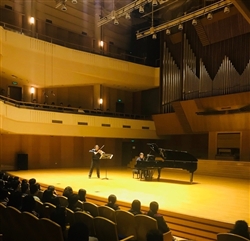
In November, Duo Volodja Balzalorsky and Peter Caelen gave concerts in 13 Chinese Million Cities at prestigeous Chinese Concert Halls, such as the Beijing Concert Hall, the Concert Hall of the Shandong Grand Theater in Jinan, Hangzhou Grand Theater and others, with a program with only works by Johannes Brahms. In Reviews are mentioned Duo's superb artistic skills, their perfect chamber music cooperation, and an unforgettable presentation of the magical music world of Brahms, for which the Duo was everywhere rewarded with long-running applause by enthusiastic audience.
Complete China Tour Schedule:
11 5 Beijing: Beijing Concert Hall
11-7 Pingxiang: Pingxiang Anyuan Grand Theatre
11-8 Hangzhou: Hanghou Theatre
11-9 Jiaxing: Jiaxing Grand Theatre
11-10 Foshan: Jinma Theatre
11-11 Dezhou: Dezhou Grand Theatre
11-13 Jinan: Concert Hall of Shandong Capital Grand Theatre
11-14 Lianyungang: Lianyungang Culture and Art Centre
11-17 Dalian: Dalian Development Zone Grand Theatre
11-18 Dalian: Dalian People’s Culture Club
11-20 Nanning: Nanning Theatre
11-21 Jiangmen: Concert Hall of Jiangmen Performing Art Centre
11-23 Wuzhou: Wuzhou Cultural Centre Grand Theatre
Superb Artistic Skills of Duo Balzalorsky-Caelen in Wuzhou, China
(external link)
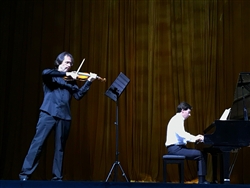
Superb Artistic Skills of Duo Balzalorsky-Caelen in Wuzhou, China
In Review are mentioned Duo's superb artistic skills, their perfect chamber music cooperation, and an unforgettable presentation of the magical music world of Brahms, for which the Duo was rewarded with long-running applause by enthusiastic audience.
Please visit + Related Link above.
High Level Performance of Duo Balzalorsky-Caelen in Jiangmen, China
(external link)
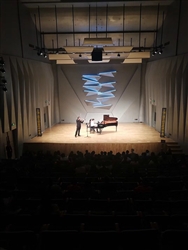
High Level Performance of Duo Balzalorsky-Caelen in Jiangmen, China
Original Article at http://mp.weixin.qq.com/s/Vf-2ejQyfHE7dOMDjfAILw
Perfect Chamber Music Cooperation of Duo Balzalorsky-Caelen at Beijing Concert Hall
(external link)
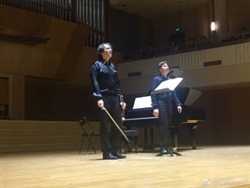
The violinist Volodja Balzalorsky and the pianist Peter Caelen at Beijing Concert Hall (November 5 2017)
Perfect Chamber Music Cooperation of Duo Balzalorsky-Caelen at Beijing Concert Hall
Original Article with Photos published on Beijing Concert Hall Official Weibo Page:
Volodja Balzalorsky & Peter Caelen to begin "China Tour" at Beijing Concert Hall with Brahms Sonatas
(external link)
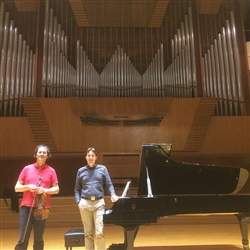
The violinist Volodja Balzalorsky and the pianist Peter Caelen will perform tonight tomorrow 5th of November at Beijing Concert Hall all sonatas for violin and piano by Johannes Brahms. This will be the first concert of the China Tour.
Complete China Tour Schedule:
11 5 Beijing: Beijing Concert Hall http://www.bjconcerthall.cn/PerformView.aspx?sn=974
11-7 Pingxiang: Pingxiang Anyuan Grand Theatre
11-8 Hangzhou: Hanghou Theatre
11-9 Jiaxing: Jiaxing Grand Theatre
11-10 Foshan: Jinma Theatre
11-11 Dezhou: Dezhou Grand Theatre
11-13 Jinan: Concert Hall of Shandong Capital Grand Theatre
11-14 Lianyungang: Lianyungang Culture and Art Centre
11-17 Dalian: Dalian Development Zone Grand Theatre
11-18 Dalian: Dalian People’s Culture Club
11-20 Nanning: Nanning Theatre
11-21 Jiangmen: Concert Hall of Jiangmen Performing Art Centre
11-23 Wuzhou: Wuzhou Cultural Centre Grand Theatre
VERY SUCCESSFUL TOUR OF AMAEL PIANO TRIO IN BENELUX/GERMANY
(Saturday, February 18, 2017) - The Amael Piano Trio (Tatjana Ognjanovic, piano, Volodja Balzalorsky, violin and Damir Hamidullin, cello) can look back on an extremely successful Benelux - Germany tour of five concerts last week:
after three splendid performances in Luxembourg, Verviers and especially in Leusden where interpretation of Smetana was rewarded with standing ovations at the end of the concert, Amael Piano Trio achieved also big success performing Alfred Schnittke trio and Brahms trio in c minor in Nordhorn (http://pronota.de/2017_02_Rezension_Amael_Piano_Trio.pdf) and again Schnittke and Beethoven's Arcduke in Assen.
The Amael Piano Trio can look back on an extremely successful Benelux - Germany tour of five concerts last week:
after three splendid performances in Luxembourg, Verviers and especially in Leusden where interpretation of Smetana was rewarded with standing ovations at the end of the concert, Amael Piano Trio achieved also big success performing Alfred Schnittke trio and Brahms trio in c minor in Nordhorn
(http://pronota.de/2017_02_Rezension_Amael_Piano_Trio.pdf) and again Schnittke and Beethoven's Arcduke in Assen.
Tour Schedule:
Tuesday, February 07, 2017 - 8pm-10pm
Foyer Europeen
12, Rue Heine, Luxembourg -ville, Luxembourg
Amael Piano Trio at "Les Concerts du Foyer Europeen
Works by Schubert, Brahms, Smetana, Lazar
Wednesday, February 08, 2017 - 7.30pm
Musée Beaux Arts de Verviers, Belgium
Rue Renier 17 Verviers, Belgium
Concert hosted by Slovenian Embassy in Brussels:
On the occasion of the celebration of Slovenian Culture Day and the 25th anniversary of diplomatic relations between Belgium and Slovenia
Thursday, February 09, 2017 - 8pm-10pm
Valleiconcerten Leusden
Stichting Valleiconcerten, Bitterschoten 48 3831 PC Leusden, Netherland
Amael Piano Trio with works by Schubert, Brahms, Lazar and Smetana
Saturday, February 11, 2017 - 8pm-10pm
Pro-Nota Concerts Nordhorn
Manz Saal im Nino Hochbau, Nordhorn, Germany (DE)
Amael Piano Trio with works by Schnittke, Brahms, Piazzolla, Lazar
http://pronota.de/2017_02_Rezension_Amael_Piano_Trio.pdf
Sunday, February 12, 2017 - 12am-2pm
Muziekkamer Assen
Podium Zuidhaege, De Schalm, Zuidhaege 2, Assen, Netherland
Amael Piano Trio with works by Schubert, Schnittke and Beethoven
Volodja Balzalorsky Receives Two Awards at Independent Music Awards
(external link)
Violinist Volodja Balzalorsky, has won an Independent Music Award for his Live performance of Karol Szymanowski Violin Sonata, performing in a Duo with the pianist Hinko Haas.
Through votes from the listening public, Volodja has been awarded the prize of "Vox Pop Winner" for his Live performance of Debussy Violin Sonata, performing in a duo with the pianist Christoph Theiler.
Additionally his new album "Volodja Balzalorsky Live: Romantic Violin Sonatas – Franck, Brahms, Grieg (Live Selection Vol . 1)" was nominated early in 2014 in the "Live Performance Album category", at the 13th Annual Independent Music Awards.
The Independent Music Awards (IMA's) is an international program that honours top ranked independent artists in more than 80 Album, Song, EP, Producer, Music Video and Design categories. The IMA's were created in 1999 by Music Resource Group (MRG). The program features previous major-label artists as well as self-released and indie lable talent from more than 70 countires on six continents.
There are two parts to The Independent Music Awards: The general voting process determined by the industry and artist judging panel. Second is the Vox Populi “voice of the people” process where fans and visitors determine the winners by rating the nominees at The Vox Populi Jukebox. Deadline to vote was July 18th, 2014.
- See more at:
Live performance winning EP Albums: Debussy / Szymanowski
http://www.independentmusicawards.com/…/13th/EP/Live-Perfor…
and
http://www.independentmusicawards.com/…/Volodja-Balzalorsky…
The 13th Annual Independent Music Awards Winners announced:
http://www.independentmusicawards.com/…/13th-annual-indepe…/
The 13th Annual Independent Music Awards Wox Pop Winners Announced:
http://www.independentmusicawards.com/…/the-13th-annual-i…/…
Listen and Follow Volodja Balzalorsky on Spotify: http://smarturl.it/9c30tj
Listen and follow Volodja on Deezer: http://smarturl.it/mm6ed2
Buy on iTunes:
Debussy Sonata: http://smarturl.it/9jrqkl
Szymanowski Sonata: http://smarturl.it/h2fm6b
Volodja Balzalorsky named Winner of 13th Annual Independent Music Awards - Live Performance EP category
(external link)

Violin-Piano Duo Volodja Balzalorsky-Hinko Haas Among The Winners of 13th Annual Independent Music Awards
- on winning top honors in the Live Performance EP category for Karol Szymanowski: Violin Sonata in D Minor - Volodja Balzalorsky Live in Concert. Volodja Balzalorsky is also Four-Tiem Nominee of 13th IMAs.
June 3, 2014 –Renowned Slovenian artists the violinst Volodja Balzalorsky and the pianist Hinko Haas are among the established and rising artists named as the judge-determined Winners of The 13th Annual Independent Music Awards (The IMAs), the influential, international awards program for independent bands and fans.
The veteran artists and rising stars named as 13th IMA Winners in more than 80 Album, EP, Song, Music Producer, Music Video and Design categories were winnowed from thousands of submissions from around the globe, and were determined by a panel of influential artists and music industry executives.
See more at: http://www.independentmusicawards.com/ima/2014/13th-annual-independent-music-awards-winners-announced/#sthash.VbXQPczu.dpuf
Four Nominations for Volodja Balzalorsky at Independent Music Awards 2014
(external link)

Four Nominations for Volodja Balzalorsky at 13th Annual Independent Music Awards "IMA"
13th Annual Live Performance Album Nominee
13th Annual Instrumental EP Nominee
13th Annual Live Performance EP Nominee (twice)
- See more at: http://www.independentmusicawards.com/ima/Volodja-Balzalorsky
Volodja Balzalorsky - the new Prersident of ESTA Slovenia
(external link)

Volodja Balzalorsky - the new Prersident of ESTA Slovenia (European String Teachers Association): elected at ESTA Slovenia General Assembly for the mandate 2013-2015.
New digital EP release: Karol Szymanowski: Violin Sonata in D Minor - Volodja Balzalorsky Live in Concert - EP
(external link)
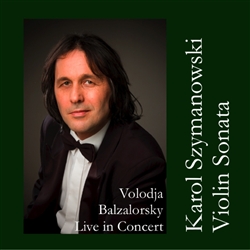
Karol Szymanowski: Violin Sonata in D Minor - Volodja Balzalorsky Live in Concert - EP
Volodja Balzalorsky, violin
Hinko Haas, piano
Karol Szymanowski (1882-1937) - Sonata for Violin and Piano in D minor op. 9
Allegro moderato - patetico
Andantino tranquillo e dolce
Allegro molto quasi presto
Recorded LIVE
at Kolarac Hall in Belgrade by Cantabel Productions (International concert series "Violin virtuosos", april 1988)
Label: Cantabel
Producer: Volodja Balzalorsky
Mastering: Silvester Žnidaršic
Cantabel Label Catalog Number: CPSDEP002
The Orchard Digital UPC: 888003639676
credits
released 20 December 2013
tags
New digital Album Release: Debussy, Janáček, Szymanowski: Sonatas for Violin and Piano (Volodja Balzalorsky Live Selection Vol. 2)
(external link)
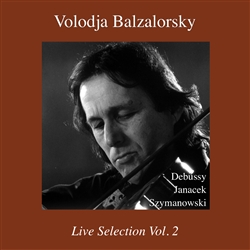
Debussy, Janácek, Szymanowski: Sonatas for Violin and Piano (Volodja Balzalorsky Live Selection Vol. 2)
New digital album relerase: Debussy, Janácek, Szymanowski: Sonatas for Violin and Piano
(Volodja Balzalorsky Live Selection Vol. 2)
Released 15 December 2013
Volodja Balzalorsky, violin
Christoph Theiler, piano (Debussy, Janácek )
Hinko Haas, piano (Szymanowski)
Claude Debussy (1862-1918) - Sonata for Violin and Piano in G minor L 140
Allegro vivo
Intermède: Fantasque et léger
Finale: Très animé
Leoš Janácek (1854-1928) – Sonata for Violin and Piano JW 7 No.7 (1914-1921)
Con moto
Ballada con moto
Allegretto
Adagio
Karol Szymanowski (1882-1937) - Sonata for Violin and Piano in D minor op. 9
Allegro moderato - patetico
Andantino tranquillo e dolce
Allegro molto quasi presto
Label: Cantabel Productions
Producer: Volodja Balzalorsky
Recorded LIVE at Kazina Hall in Maribor by Radio Slovenija - Regionalni RTV center Maribor (International Chamber Music Series of Maribor, November 1989 - Debussy),
at Bösendorfer Hall in Vienna by Cantabel Productions (International Chamber Music series, 07/03 1996 - Janácek).
at Kolarac Hall in Belgrade by Cantabel Productions (International concert series "Violin virtuosos", april 1988 - Szymanowski)
Mastering: Silvester Žnidaršic (Debussy, Szymanowski)
Andrej Rode (Janácek)
Cantabel Label Catalog Number: CPSDA002
Pre- Release Version: Live - Compilation
The Orchard Digital UPC: 888003039797
Wordwide digital distribution through The Orchard: 12/15/2013
www.theorchard.com/artist/464041/releases/volodja-balzalorsky
credits
released 15 December 2013
New digital EP Release: Claude Debussy: Violin Sonata - Volodja Balzalorsky Live in Concert - EP
(external link)
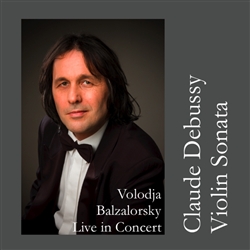
New digital EP Release: Claude Debussy: Violin Sonata - Volodja Balzalorsky Live in Concert - EP
Volodja Balzalorsky, violin
Christoph Theiler, piano
Claude Debussy (1862-1918) - Sonata for Violin and Piano in G minor L 140
Allegro vivo
Intermède: Fantasque et léger
Finale: Très animé
Released 1 December 2013
Label: Cantabel Productions
Producer: Volodja Balzalorsky
Recorded LIVE at Kazina Hall in Maribor by Radio Slovenija - Regionalni RTV center Maribor (International Chamber Music Series of Maribor, November 1989),
Mastering: Silvester Žnidaršic
Cantabel Label Catalog Number: CPSDEP01
The Orchard Didital UPC: 888003033498
Wordwide digital distribution through The Orchard: 12/01/2013
www.theorchard.com/release/888003033498/volodja-balzalorsky/claude-debussy-violin-sonata-volodja-balzalorsky-live-
released 01 December 2013
New digital Release: Romantic Violin Sonatas: Franck, Brahms, Grieg - Volodja Balzalorsky Live Selection No.1
(external link)
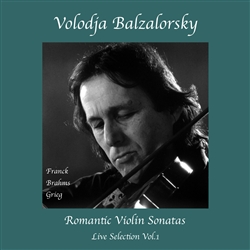
Volodja Balzalorsky Live: Romantic Violin Sonatas - Franck, Brahms, Grieg (Live Selection Vol.1)
Live recordings from Belgrade, Vienna and Rogaska Slatina
Volodja Balzalorsky, violin
Hinko Haas, piano (Franck)
Christoph Theiler, piano (Brahms, Grieg)
César Franck (1822-1890): Sonata for Violin and Piano in A major
Allegro moderato
Allegro
Recitativo-Fantasia moderato
Allegretto poco mosso
Johannes Brahms (1833-1897): Sonata for Violin and Piano No. 3 in D minor op.108
Allegro
Adagio
Un poco presto e con sentimento
Presto agitato
Edvard Grieg (1843-1907): Sonata for Violin and Piano No.3 in C minor op. 45
Allegro molto ed appassionato
Romanza - Allegretto molto espressivo
Allegro animato
Label: Cantabel Productions
Producer: Volodja Balzalorsky
Recorded LIVE at Kolarac Hall in Belgrade by Cantabel Productions (International concert series "Violin virtuosos", april 1988 - Franck),
at Bösendorfer Hall in Vienna by Cantabel Productions (International Chamber Music series, 07/03 1996 - Brahms)
and Crystal Hall in Rogaška Slatina by Radio Slovenia - Regionalni RTV center Maribor (Festival “Rogaška Summer”, September 1995: Grieg)
Cantabel Label Catalog Number: CPSDA01
The Orchard Digital UPC: 888003033511
Worldwide digital distribution through The Orchard 11/15/2013
www.theorchard.com/release/888003033511/volodja-balzalorsky/romantic-violin-sonatas-live-selection-vol-1
credits
released 15 November 2013
All Music Guide CD Review: Volodja Balzalorsky Live in Maribor
(external link)
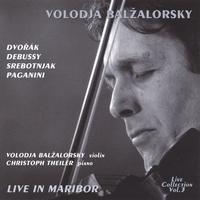
All Music Guide
Review by James Leonard
Volodja Balzalorsky Live in Maribor is Volume 3 of the Volodja Balzalorsky Live Collection released by Balzalorsky's Cantabel Productions. Slovene-born, German-Austrian-trained, and Ljubljana-based, Balzalorsky is not only a one-man production company; he is also, according to the notes, a violinist with a polished technique and a rich, warm tone with a sensitive, intelligent, and intuitive gift for interpretation. As it turns out, all this is in fact true. Balzalorsky may be a relentless self-promoter but he is also an intelligent artist with sweet tone and a smooth technique. In this 1989 issue from the International Chamber Music Series of Maribor, Balzalorsky's Dvorák Sonatina is delightful and soulful, his Debussy Sonata is light and ethereal, his Paganini Cantabile is ripe and tender, and his Srebotnjak Sonata No. 1 is powerful and persuasive. With the sympathetic accompaniment of German pianist Christoph Theiler, Balzalorsky's performances are easily in the same league as many of the better international performances of the past 20 years and well worth hearing. Cantabel's sound is raw but honest.
International acclaim for Amael Trio performing in New York, London and in Rome
(external link)
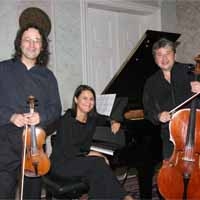
Source: (http://www.myprgenie.com) by Cantabel Productions
A large Multi-national audience rewarded the Amael Piano Trio with
thunderous applause and prolonged ovations at the sold-out Christmas Concert in Rome, which completed a series of very successful Amael Trio performances at several international festivals, including concerts at Weill Recital Hall at Carnegie Hall in New York and at The Forge in London, for which Amael Trio received outstanding acclaim, both by the critics as well as by the audience, and thus confirmed its reputation and international recognition already achieved in the past.
A top-notch ensemble, the Amael Piano Trio!
New York Concert Review
(Weill Recital Hall at Carnegie Hall, New York, NY November 13 2010)
...a superb Beethoven's 'Archduke', full-blooded in tone yet also respectful of structural clarity. Magical colouring of modulations, highlighting of luminescent thrilling, and fresh shades...
The Classical Source
(The Forge, London, November 30 2010)
... The concert of Amael Piano Trio shall remain reasonably be remembered as a great artistic event of valuable guest artists from Slovenia...
Radio Belgrade
(Great Hall of Kolarac Belgrade, October 24 2010)
In addition to the repertoire of classical music, the Trio Amael at all concerts promoted and performed a number of works by Slovenian composers.
According to New York Concert Review Amael Trio did an excellent job... they represented Slovenia with honor: ..."Maestoso Lugubre" by Slovenian composer Lucijan Marija Skerjanc ... a somber lyricism pervaded, deepened by each player's entry. The synchronization was marvelous, particularly in the string doublings... All three blended in a way that was rich and warm, but also translucent, like the sonic equivalent of amber... New York Concert Review
Amael Trio was also honored to play the opening concert of two important festivals of contemporary music (The Forfest in Kromeríz, Czech Republic and The Festival Nuovi Spazi Musicali. in Rome), where the trio also very successfuly performed four World Premieres, new compositions for piano trio written by Hugh Levick, Streven Mento, Massimiliano Messieri and Andrea Morriconne.
Concert Highlights of Amael Piano Trio for 2011
Highlights of Amael Piano Trio for 2011 include invitation to perform at the 25th SXSW Festival in Austin in March, Croatian tour in May, German Tour in October (including concerts in Gasteig in Munich and concert at The Spectrum Festival Nordhorn), and England tour in November.
New Amael Piano Trio Releases are planned in 2011 on Cantabel label and on Eroica Classical Recordings label: Amael Piano Trio Live from Spectrum Festival featuring works by Alfred Schnittke, Astor Piazzolla, and Johannes Brahms and additional release with works by Haydn, Schubert adn Beethoven.
Amael Piano Trio in Review 2010: (more extracts)
The Classical Source
...Yet the Variations of the "Archduke's" third movement was the highpoint, a transcendent, calm flowing beauty of tone, the rhetoric involving and absorbing...The Classical Source
Read the whole review:
http://www.classicalsource.com/db_control/db_concert_review.php?id=8755
New York Concert Review
...Amael Trio brought unity and vigor to both old and new...The synchronization was marvelous, particularly in the string doublings.... All three blended in a way that was rich and warm, but also translucent, like the sonic equivalent of amber...The performance (Five short pieces by Slovenian composer Milko Lazar) was one of extreme precision, and it would be hard to imagine it being played more convincingly than it was by this tightly knit ensemble... it was a fulfilling musical evening, and this is a superb ensemble. New York Concert Review
Read the whole review:
http://www.nyconcertreview.com/blog/?p=1030
Radio Belgrade - Cultural Program
..."Maestoso lugubre" by Lucijan Maria Skerjanc.
Oppressed by the tragedy of this score, which requires balancing of pathos and restraint, was realized through a saturated, dark sound range, and deep sound conformation, which occurs only as a result of common breathing...
Playing in some parts of the "Nocturne" by Shubert on the very threshold of hearing, members of the trio Amael here demonstrated exceptional subtlety of mutual listening, like the kind of prompt with silence...
After only a brief introduction of the first paragraph, in which, after performing a solo piano, imperceptibly interfere section violin and cello, it was clear from how much restraint, lyricism and, why not, the nobility, the AmaelPiano Trio interpret Beethoven's music
2010-11 Highlights, Reviews from Volodja Balzalorsky
(external link)
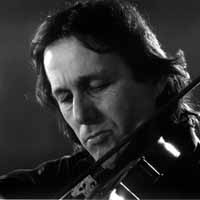
Source (http://www.myprgenie.com) by Cantabel Productions
Cantabel Productions is delighted to announce some excited news about our artist, the violinist Volodja Balzalorsky, who has been awarded several prestigious music awards in the past couple of years
Volodja Balzalorsky has been making a splash in the US and Canada, winning The Hollywood Music in Media Award 2009, The Inland Empire Music Award for Best International Artist in 2008, The Ontario Independent Music Award in 2007, and was a nominee for The Los Angeles Music Award 2007 and 2008 and a nominee for The Hollywood Music Award 2008.
Volodja Balzalorsky also received the Canary Islands Music Award 2007 in Spain, and the Betetto Music Award (2006), the highest music award given in Slovenia.
According to Fanfare -- The Magazine for Serius Record Collectors, Volodja Balzalorsky's four CDs on Cantabel have made available some stunning live performances, all reviewed in 2010-issues of Fanfare and deserve high recommendation. Compared with some great violin legends such as Kreisler, Szigeti, Oistrakh and Stern, Balzalorsky's Live recordings received the highest critical acclaim.
Reviews are also available online as a part of Fanfare archive: http://www.fanfarearchive.com (for subscribers only).
Mr. Balzalorsky was invited by Fanfare Magazine for an interview, which was published in Nov/Dec Issue of Fanfare under section "Feature Articles" entitled "Volodja Balzalorsky Shares His Views of Violinistic Development and Artistic Interpretation"
Available online: http://www.fanfaremag.com/content/view/40743/10245/
Volodja Balzalorsky received also high critical acclaim from All Music Guide:
..."Balzalorsky's performances are easily in the same league as many of the better international performances of the past 20 years and well worth hearing..."
In 2011 Cantabel will continue with releases of Balzalorsky's Live recordings. The next, fifth release of the Live Collection will be from the Spectrum Festival, performed by Amael Trio in works by Brahms, Glinka, Schnittke, and Piazzolla. With this release, the series of five concerts-five CDs (each concert, one CD) will be completed.
Balzalorsky's 2009-2010 seasons brought recital, solo and chamber music performances in Italy, Germany, Norway, United Kingdom, Croatia, Serbia, Czech Republic, Slovakia, Slovenia, and in USA, including performances at Ljubljana Festival, in Gasteig, Munich with Cheltenham Symphony Orchestra performing Brahms Concerto, recital at The Red Hedgehog Celebrity Concert Series in London, at SXSW Festival 2009 and 2010 in Austin, performances at Carnegie Hall in New York (ArrivaDiva Master Recital Series 2009 and Festival Spectrum in November 2010), as well as additional performances with Amael Piano Trio.
Some Concert Reviews Extracts:
...Something Wild for violin solo by Nenad First, an intriguing work that Volodja Balzalorsky projected with stunning virtuosity and gripping energy. In the hands of this subtle yet communicative artist the violin came alive, with pointed pizzicato, incisive double-stopping and rapid passagework adding to the relentless excitement...
The Classical Source - November 30 2010 2010 http://www.classicalsource.com/db_control/db_concert_review.php?id=8755
"Ovations for Volodja Balzalorsky and Hinko Haas at Nordland Music Festival in Bodo, Norway, "Slovenere begeistret i Rønvik" ("Slovenians thrilled the audience in Rønvik")" Avista Nordland
Vololodja balzalorsky played Brahms concerto with verve and feeling; the gypsy-Hungarian roots of the music were most apparen. Both soloist and orchestra deserved the standing ovation that the normally restrained audience awarded them at the end. Gloucestershire Echo
Volodja Balzalorsky was particularly active with his Amael Piano Trio performing with a great success at several international festivals and international chamber music concert series in New York, London, twice in Rome, Belgrade, San Marino, Bergen, Munich, Nis, Kromeriz
Amael Piano Trio in Review:
November 30 2010 Concert in London at The Forge ...a superb 'Archduke', full-blooded in tone yet also respectful of structural clarity. Magical colouring of modulations, highlighting of luminescent thrilling...Yet the Variations of the third movement was the highpoint, a transcendent, calm flowing beauty of tone, the rhetoric involving and absorbing...
The Classical Source http://www.classicalsource.com/db_control/db_concert_review.php?id=8755
Weill Recital Hall at Carnegie Hall, New York, NY (November 13, 2010)
A top-notch ensemble, the Amael Piano Trio!... In a program of 20th-century Slovenian music and Beethoven's "Archduke," they brought unity and vigor to both old and new...The synchronization was marvelous, particularly in the string doublings.... All three blended in a way that was rich and warm, but also translucent, like the sonic equivalent of amber...The performance was one of extreme precision, and it would be hard to imagine it being played more convincingly than it was by this tightly knit ensemble ...it was a fulfilling musical evening, and this is a superb ensemble...
New York Concert Review http://www.nyconcertreview.com/blog/?p=1030
Concert Highlights of Volodja Balzalorsky for 2011 include two performances at 25th SXSW Festival in Austin in March, Croatian tour in May, Amael Piano Trio German Tour in October, including concerts in Gasteig in Munich and concert at Festival Spectrum Nordhorn, and England tour in November.
For more information about Volodja Balzalorsky's upcoming concerts, free mp3 download-airplay quality and where to buy his recordings (albums and downloads), please visit the following web pages:
Official web page of Volodja Balzalorsky: www.balzalorsky.net
Electronic Press Kit: High resolution Photos for download: www.sonicbids.com/balzalorsky
New Album Releases on MySpace: www.myspace.com/balzalorsky/music
Fan page of Volodja Balzalorsky on Facebook: www.facebook.com/balzalorsky
Follow Volodja Balzalorsky on Twitter: www.twitter.com/balzalorsky
Free mp3 download for fans: www.reverbnation.com/volodjabalzalorsky
Latest digital releases:
Latest digital releases of Balzalorsky's Live Collection in December 2009: in United Kingdom on 7digital, Amazon.co.uk, and MySpace UK, in Germany on Amazon.de and T-Online/Musicload, in France on Amazon.fr in US on Medianet, MySpace.com, Puretracks.com and Spotify, in Japan on Amazon.jp and in China on R2G.
The Classical Source Concert Review: Amael Piano Trio at The Forge, London
(external link)
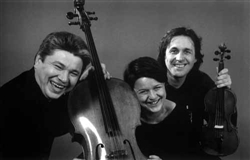
The Classical Source Concert Review:
Amael Piano Trio at The Forge, London
Reviewed by: Malcolm Miller
The members of the Amael Piano Trio have a large discography and numerous works composed for them. On this occasion they presented a fascinating selection of Slovenian music and a riveting interpretation of Beethoven’s ‘Archduke’.
Pride of place was accorded to Maestoso lugubre by one of the leading Slovenian composers, Lucijan Marija Skerjanc (1900-1973), a multi-talented musician – pianist, conductor, composer and head of the Ljubljana Academy of Music – who composed it when he was thirty-five, as the finale of a 45-minute work. The movement starts with a Hindemith-like fugue based on a widely contoured subject, introduced here with strident resonance by Damir Hamidulin. The work evolves a more opulent chromatic impressionism reminiscent of Delius, with crunchy piano chords overlaid by expansive, sustained melodies in octaves for strings. There is a funereal dotted-rhythm procession assigned to the piano at the mid-point, which Tatjana Ognjanovic projected with compelling character, highlighting the biting, ostinato-laden bittersweet flavour suggestive of Shostakovich. In the final section there are several passages of exquisite beauty which counter the general dour mood, but the ending is a darker procession for piano alone.
In a more experimental atonal idiom was Something Wild by Nenad First (born 1964), an intriguing work that Volodja Balzalorsky projected with stunning virtuosity and gripping energy. In the hands of this subtle yet communicative artist the violin came alive, with pointed pizzicato, incisive double-stopping and rapid passagework adding to the relentless excitement.
A more radical exploration of the piano trio emerged in Five Short Pieces by Milko Lazar (born 1965). Composed in 2001 for the Amael musicians, each of the movements is vividly contrasted and finely crafted, alert to a range of influences including minimalism, jazz harmonies and rock rhythms. The two slow movements, second and fourth, evoked poetic imagery in the spare use of tiny ostinato patterns and wisps of melody; in the second (‘Largo lamento’) an atmospheric texture of high violin and low piano chords frame an elegiac cello melody. The faster movements radiated energy and panache, with quick-fire repeated-note motifs and fizzing syncopations.
The concert concluded with a superb ‘Archduke’, full-blooded in tone yet also respectful of structural clarity. Magical colouring of modulations, highlighting of luminescent trilling, and fresh shades, lifted this performance above the usual. The fast tempo for the scherzo contributed to its lively imitative dialogues, and also the syncopations of the jocular finale. Yet the Variations of the third movement was the highpoint, a transcendent, calm flowing beauty of tone, the rhetoric involving and absorbing. The Amael Piano Trio was on top form and will be welcome in London again and often.
New York Concert Review: Amael Piano Trio, in Review
(external link)
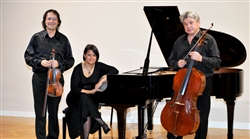
by Rorianne Schrade for New York Concert Review; New York, NY
(Weill Recital Hall at Carnegie Hall, New York, NY November 13 2010)
A top-notch ensemble, the Amael Piano Trio, was presented this weekend under the auspices of the Spectrum Chamber Music Society, with the support of the Ministry of Culture of the Republic of Slovenia. In a program of 20th-century Slovenian music (first half) and Beethoven’s Piano Trio in B-flat, Op. 97, the “Archduke” (second half), they brought unity and vigor to both old and new.
The Amael Trio, based in Ljubljana, states in its biography (in addition to mentioning traditional repertoire) that it is “dedicated to performing contemporary works, and to the promotion, internationally, of Slovenian composers of piano trio literature.” They did an excellent job of just that in their Saturday evening program, and though only the pianist and violinist are natives of Slovenia (the cellist hailing from Russia), they represented Slovenia with honor. They might add to their biography that they also promote some non-trio works, as there was a violin solo included on their program; considering that each of the three players is of such strong individual ability, they might want to incorporate some solos or duos by the pianist and cellist as well. It would be a welcome addition.
The concert opened in an intensely dark vein with “Maestoso Lugubre” by Lucijan Marija Skerjanc (1900-1973). Composed in 1935, the work is actually the last movement of this composer’s Piano Trio, though Skerjanc himself suggested that it be performed as a single work. From the very first solo cello notes by Damir Hamidullin, a somber lyricism pervaded, deepened by each player’s entry. The synchronization was marvelous, particularly in the string doublings (which can so easily sound “off” but were never so). All three blended in a way that was rich and warm, but also translucent, like the sonic equivalent of amber. The pianist, Tatjana Ognjanovic, managed to be the perfect foundation and “glue” for the trio without any suggestion of dominance even with the Steinway lid up.
Violinist Volodja Balzalorsky came onstage next as soloist in “Something Wild” by Nenad First (b. 1964). Mr. First, though born in Zagreb, lives and works in Slovenia. “Something Wild” is pretty much what its title suggests, a rhapsodic, virtuoso violin showpiece with a rough, rustic streak (plenty of fifths) and dizzying speed (think Bartok meets Paganini). Seemingly fiendishly difficult in parts, it was the compulsory violin work in the 2005 International Johannes Brahms Competition. While I cannot profess to love the piece, it was an intriguing break from the trios and certainly an opportunity for Mr. Balzalorsky to shine.
The first half concluded with the trio performing “Five Short Pieces” by Milko Lazar (b. 1965). Dedicated to the trio in 2001, it is a work of great variety within concise, classically restrained movements, each contrasting with the last (arranged as fast, slow, fast, slow, fast). The performance was one of extreme precision, and it would be hard to imagine it being played more convincingly than it was by this tightly knit ensemble.
Beethoven’s “Archduke” Trio, a masterpiece that is reason enough to go to any concert, was given a fine, mostly polished performance for the evening’s close. Performers are unfortunately subject to the accumulated preferences of a listener when performing such an established masterpiece, and I felt it was slightly unsettled in parts. Occasionally it was a matter of simply needing more agogic placement of downbeats (as in the first movement’s initial move to G major, where a more settled metric feeling can enhance ensuing rhythmic surprises), but other times (as in the magnificent third movement) it seemed that the pursuit of momentum was undermining the overarching grandeur of the work. All in all, though, it was a fulfilling musical evening, and this is a superb ensemble, which I hope to hear again.
Concert Review-Radio Belgrade: Amael Piano Trio in Belgrade "International Kolarac Chamber Music Podium
(external link)
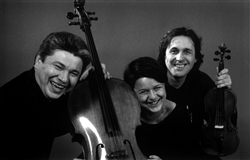
Radio Belgrade: Review by Ivana Komadina
Amael PianoTrio, which had yesterday, 24 October debut in front of the Belgrade audience in the great Kolarac Hall, established eleven years ago the top three Slovenian artists, the pianist Tatiana Ognjanovic, violinist Volodja Balzalorsky and the cellist Damier Hamidullin.
The ensemble of enviable international reputation, for its debut in Belgrade selected works by Skerjanc, Schubert and Beethoven.
All three artists of this trio are prominent soloists, which was seen immediately at the beginning of the concert: luxurious, cultivated color of tone, and the technical mastery of each individual.
Their input total permeation in the joint performance of the music, presented as early as the first part of the program, the composition "Maestoso lugubre" by Lucijan Maria Skerjanc.
Oppressed by the tragedy of this score, which requires balancing of pathos and restraint, was realized through a saturated, dark sound range, and deep sound conformation, which occurs only as a result of common breathing.
Great opportunity for Belgrade fans of chamber music, in this manner to experience Slovenian work by L.M. Skerjanc: in a top, inspired performance of the trio Amael.
Trio in E Flat Major by Franz Schubert, like some kind of musical portrait of the harp, made a completely different kind of challenge: to create a transparent atmosphere, that seems to arise from nothing, from the flicker of air, which is only at moments condensed into clearly defined contours sound. Playing in some parts of the composition on the very threshold of hearing, members of the trio Amael here demonstrated exceptional subtlety of mutual listening, like the kind of prompt with silence.
After these two compositions with completely different sides of musical expression, Amael Trio rounded the concert with interpretation of technical and interpretative challenging Piano Trio opus 97 in B - Major Ludwig van Beethoven. This classic chamber music literature by the author himself considered it one of his best works, is one of the few in its genre in which all three of the performers set equally high demands.
After only a brief introduction of the first paragraph, in which, after performing a solo piano, imperceptibly interfere section violin and cello, it was clear from how much restraint, lyricism and, why not, the nobility, the trio Ognjanovic - Balzalorsky - Hamidulin interpret Beethoven's music. This is precisely the reason that ARS SONORO today round up their interpretation of the final part of the first paragraph of this trio.
The concert of Amael Piano Trio shall remain reasonably be remembered as a great artistic event of valuable guest artists from Slovenia.
Ivana Komadina, musicologist - a critic, music editor of the Second Program of Radio Belgrade - Cultural Program
Fanfare Review: CD Volodja Balzalorsky Live in Conceret Vol. 3: Live in Maribor
(external link)
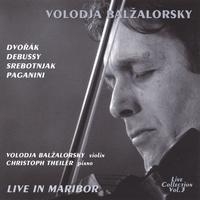
CD Review by Robert Maxham
VOLODJA BALZALORSKY LIVE IN MARIBOR • Volodja Balzalorsky (vn); Christoph Theiler (pn) • CANTABEL 003 (45:58) Live: Malibor 11/1989
DVORAK Violin Sonatina. DEBUSSY Violin Sonata. SREBOTNJAK Violin Sonatina No. 1. PAGANINI Cantabile
The third volume of Volodja Balzalorsky’s “Live Collection” presents a recital given by Balzalorsky and pianist Christoph Theiler in Kazina Hall in Maribor, and recorded by Radio Sloveni-Regionalni RTV, in 1989. The duo opened the program on that occasion with Dvorakk’s Sonatina, its first movement (and the opening of the second) suffused with glowing warmth and the charming rhythmic patterns teased cleverly out of the Larghetto’s middle section. Balzalorsky studied for a while with Josef Suk in Vienna, and he plays the Sonatina’s Scherzo as though he had written it, with particularly insinuating subtlety in the trio. The work has been called the “Indian Sonatina” because of its connections with Iowa and Minnesota, but Balzalorsky colors it middle European rather than middle American. If, after the first three movements, he seems to press in the Finale, his rhythmic energy and robust tone tie it—especially its reflective penultimate passage—to the other movements.
The first movement of Debussy’s Sonata in Balzalorsky’s performance sounds slinky and ethereal in its first movement, with appropriately reedy and highly inflected tone production, while Theiler provides shimmering background. I’ve watched David Oistrakh playing this work with Frida Bauer (on VHS, Kultur 1208) many times, but he didn’t seem to make as many timbral adjustments (neither did Isaac Stern in his recording from 1960) as does Balzalorsky in order to realize the movement’s full potential (Joseph Szigeti did—at least almost did—in his 1940 recital with Bartók, though the recorded sound doesn’t allow listeners to hear all of the expressive detail they seemed to produce). The Intermède: Fantasque et léger, however, sounds generally heavier and less fantasque in Balzalorsky’s reading (especially in the central section’s repeated notes) than it does in either of these others so that the return to greater poignancy at its end provides a lower level of contrast. Nevertheless, Balzalorsky’s final passage suggests pastels, though haunting ones. The duo begins the last movement slowly, but quickly turns to a sort of sharp-edged articulation that lends the movement unusual excitement almost to the end.
The three movements of Alojz Srebotnjak’s First Sonatina last only about eight minutes. The opening Allegro deciso, crisply rhythmic and tonal, assigns to the piano the role of a relatively equal partner, and Balzalorsky and Theiler collaborate in it with energetic élan. The slow movement begins with a plaintive song for solo violin. Balzalorsky invests its singing melodies with great beauty of tone, and Theiler provides suggestive commentary. The finale, Danza, returns to the first movement’s rhythmic piquancy and sharp definition, with the violin at the outset setting the pace with slashing double-stops reminiscent of those in Stravinsky’s Violin Concerto. In general, it’s a work and a performance that collectors and explorers of all kinds should welcome—including the closing reading of Paganini’s brief Cantabile (so often played with guitar) epitomizing elegant refinement and suave tonal charm.
If the CD’s short duration gives anyone pause, the program’s general excellence (as well as the vibrant recorded sound) should, in this case, compensate in some measure, especially since the program represents a single live performance. Recommended. Robert Maxham
This article originally appeared in Issue 33:6 (July/Aug 2010) of Fanfare Magazine.
Fanfare Review: CD Volodja Balzalorsky Live in Concert Vol. 2: Live in Belgrade
(external link)
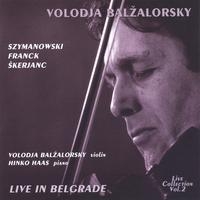
CD Review by Robert Maxham
SZYMANOWSKI Violin Sonata. FRANCK Violin Sonata. SKERJANC Liricna bagatela • Volodja BalLžalorsky (vn); Hinko Haas (pn) • CANTABEL 002 (52:39) Live: Belgrade 4/1998
Volodja Balzalorsky Live in Concert Vol. 2: Sonatas for Violin and Piano by Franck & Szymanowski (Live in Belgrade)
MP3 Download
Cantabel Productions
The second volume of Volodja Balzalorsky’s “Live Collection” presents a recital he gave in April 1998, with pianist Hinko Haas in Kolarac Hall in Belgrade. The program opened with Karol Szymanowski’s ripely romantic Violin Sonata, a piece first performed by Paul Kochánski and Anton Rubinstein in 1909 (by way of reference, the two violin concertos come from 1916 and 1933 and the relatively popular Mythes and Notturno e Tarantella, from 1916). But however early in his production, Szymanowski’s sonata seems especially well suited to a violinist who understands the somewhat elusive though ecstatic harmonic language that underpins some of the work’s most traditional-sounding passagework (remember the way in which Szymanowski underlayered Paganini’s Caprices Nos. 20, 21, and 24 with his own rich harmonic substratum). Balzalorsky and Haas seem particularly unconstricted breathing this somewhat heavy and slightly exotic atmosphere, notably, perhaps, in the second movement. They begin the third with an energy similar to that which they generated at the opening of the first, an energy that Balzalorsky maintains at times by means of a tone just raw enough to create an occasional frisson at climactic moments. And they bring the movement to a blazing conclusion.
In Franck’s Sonata, one of the repertoire’s staples (Heifetz chose it for his last recital), they invite comparison with the great performances through the history of recording. But Balzalorsky’s ability to turn and twist his tone, and the performers’ joint sympathy for Franck’s expressive harmonic language (think of the haunting ninth chords at the opening of the piano part) and surging passages give them a strong foothold in the first movement. They slightly hold back climaxes, making them just bearable, and exhibit a wide dynamic range in exploring the movement’s subtleties. In the engineers’ recorded sound, Balzalorsky’s entrance in the second movement seems almost cavernous, but they’ve by no means diminished the urgency of his reading. Compared to Isaac Stern’s raw energy, Balzalorsky’s seems super-subtleized in this sonata (Franck wrote it as a wedding present for Eugène Ysaÿe, who could strike sparks in the last movement of Mendelssohn’s Concerto but who, as a composer, could also lead violinists through rhapsodic serpentine chromaticism in his own solo violin sonatas). Balzalorsky and Haas know how to fall back before springing (as they do at the movement’s end), and the effect can be overwhelming. The duo opens the canonic last movement at a somewhat slow tempo, but Balzalorsky plays with a subtly varied tone that continuously enlivens the musical interest until their shattering final pages. After the intensity of their reading of Franck’s finale, Lucjan Marija Skerjanc’s two-minute Liricna bagatela comes as sweetmeat. (According to the jewel case, Skerjanc lived between 1900 and 1973.)
If Balzalorsky’s tone doesn’t always sound lush, that may be partly due to the engineering, but he also may not seek tonal opulence, as do many, as an end in itself. For the inherent interest of the program and for the performances themselves, the release deserves a high recommendation. Robert Maxham
This article originally appeared in Issue 33:6 (July/Aug 2010) of Fanfare Magazine.
Fanfare Reviews: Volodja Balzalorsky's Live Collection Vol. 1 and 4
(external link)
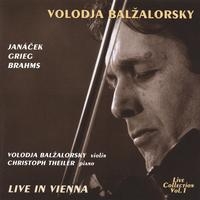
CD Review by Robert Maxham
JANAC?EK Violin Sonata. GRIEG Violin Sonata No. 3. BRAHMS Violin Sonata No. 3 •
Volodja Balzalorsky (vn); Christoph Theiler (pn) • CANTABEL 001 (64:17) Live: Vienna 3/7/1996
Volodja Balzalorsky (vn); Christoph Theiler (pn) • CANTABEL 004 (62: 07) Live: Rogaska 9/1995
Two of the releases in Cantabel’s “Live Collection” series present the duo of Slovenian violinist Volodja Balzalorsky and German pianist Christoph Theiler in identical programs, one in Vienna on March 7, 1996, and the other in Rogaska in September 1995. In JanáÄek’s sonata, the Vienna performances of the first two movements each ran 10 seconds longer than those at Rogaška. Similarly, the first and last movements of Grieg’s sonata both took about 44 seconds longer in Vienna than did the corresponding performances in Rogaška, while the timings for the other movements and the entire Brahms sonata differed by only a few seconds, respectively. Yet the generally slower tempos in Vienna seem consistent enough to deserve notice.
In Vienna, the first movement of Janacek’s sonata sounded more kittenish than ominous, though Balzalorsky’s tone possesses the fibrous strength (and, where necessary, the richness) to express ideas of any voltage. The recorded sound (from the Bösendorfer Hall) seems a bit cavernous. I didn’t touch my dial, as TV announcers have continually warned me not to, between performances, but neither the closer miking at Rogaska nor the 10 seconds of difference between the timings could entirely explain the greater urgency of the earlier performance. In Vienna, the second movement sounded richly lyrical; in Rogaska, perhaps because of the closeness of the miking, Balzalorsky programatically, it should, in both venues. The fourth offers the violinist opportunities for mixing the vaulting with the haunting, and Balzalorsky, the disturbing interruptions may seem to some listeners to make the deeper impression, and the conclusion seems more troubling emotionally.
In Vienna, Balzalorsky and Theiler played with drive and ardor in the first movement of Grieg’s C-Minor Sonata, imparting special piquancy to the off-beat accompanying figures (even in Kreisler’s celebrated performance with Rachmaninoff, they don’t tease the violin part so impudently), and Theiler introduces the coda with a tantalizing sense of expectancy; the performance in Rogaska opens even more stormily (remember, it’s 44 seconds shorter). In fact, it’s an electrical storm, with enough voltage to knock Ben Franklin’s kite out of the air, if not electrocute its flier. But if the accompanying patterns mentioned above sound more perfunctory, the faster tempo may be responsible; the performance, for all its closeness to the microphones, nevertheless seems highly nuanced. Theiler played the simple opening of the second movement with heartfelt poetic sensitivity, which Balzalorsky’s more straightforward reading of the theme seemed to match principally in tempo; if he didn’t equal Kreisler and Rachmaninoff’s rhythmic verve in the central section, he achieved his own sort of élan. Theiler sounded equally sensitive in Rogaska—at a noticeably faster tempo in the opening measures; Balzalorsky drew, in this venue, upon the full resources of his instrument to create a glowing account of the violin part, drawing up to equal partnership with Theiler throughout the movement. The third movement sounded dramatic in Vienna, despite a somewhat slow tempo, and Balzalorsky played the yearning second theme with a sweet tone that darkened on the G string, never growing hoarse, even as the passages climbed into the string’s throatiest registers—and he punctuated it with thrilling, sharp accents. If this reading of the movement seemed to lack forward drive, the duo compensated for it in their blazing account of the last pages. Although the applause sounds tepid, it’s hard to understand why. The performance in Rogaska took a similar approach, although the first time I heard it, Balzalorsky seemed strained, but that impression faded even upon a second hearing. And he played the sighing gestures in the secondary theme with a genuine sob. Perhaps inspired by BalLžalorsky, Theiler executed a transition of exceptional sensitivity from the singing passage back to the leaping initial one. Still, the duo didn’t take off with lightning rapidity in the coda in this reading. Both performances sound as though they might have been taped in performances by Norway’s fiddling (Hardanger fiddle?) troll, Fossegrimmen.
However deeply felt their reading of Grieg’s sonata, Balzalorsky and Theiler possibly communicated with each other most effectively in Brahms’s D-Minor Sonata. Their reading of the first movement in both venues conveyed the work’s somber glow (although the one in Rogaška seems at the same time, paradoxically, slightly more subtle and slightly more magisterial), enhanced by Balzalorsky’s buttery tone, which, however, lacked nothing in tensile strength when Brahms’s angular passagework requires it. The duo gave a deeply moving account of the slow movement in both venues, too, although with the expressivity, perhaps, less forced and more directly appealing in Vienna. The noticeably quicker pace of the third movement in Rogaska’s more relaxed elegance. Yet the more headlong performance of the finale in Rogaska didn’t steamroll a wealth of detail richer than that in the Vienna performance.
Since both CDs share the same photograph and, except for the title on the cover, the same booklet—as well, of course, as the same program—listening to them elicits a question similar to the one TV announcers posed about twins and a home-permanent product several decades ago: Which twin ... ? In this case, since the recorded sound seems so much edgier in the Rogaška recital, it’s tempting to give the nod to the Vienna disc, but to acquire only that one would be to miss much of depth and beauty. Both recommended. Robert Maxham
This article originally appeared in Issue 33:5 (May/June 2010) of Fanfare Magazine.
Violinist Volodja Balzalorsky has been Awarded Five Prestigious Music Prizes in US, Canada, Spain and in Slovenia
(external link)
(PRWEB) December 17, 2009
Recently Volodja Balzalorsky received his 5th music award in the past three years, in the category "Classical Music" at the Hollywood Music in Media Awards in front of some of Hollywood's most famous Music Industry professionals.
Cantabel Productions is delighted to announce that Volodja Balzalorsky received the "Hollywood Music In Media Award - Best Classical" in the category classical music for his Live Collection (four albums), released by Eroica Classical Recordings and Cantabel Productions, now available on iTunes, Amazon, Rhapsody, eMusic and all major digital outlets.
The live collection of Volodja Balzalorsky, is a unique presentation featuring the violinist with his chamber music partners, from 1985 to the present. The performances are taken from live national broadcasts, international festivals and concert series, around the world.
The Hollywood Music In Media Awards recognizes and honors the music of independent artists from around the globe. Both mainstream and independent artists are honored as peers for their compositions and recordings in all forms of media. The Hollywood Music In Media Awards (HMMA) was presented Thursday, November 19th, 2009 at The Highlands in the world famous Hollywood & Highlands / Kodak Theater complex in Hollywood, CA.
For the past couple of years Volodja Balzalorsky has been making a splash in the US and Canada, winning also the Inland Empire Music Award for Best International Artist in 2008, the Ontario Independent Music Award in 2007, and was a nominee for the Los Angeles Music Award 2007 and 2008 and a nominee for Hollywood Music Award 2008.
Volodja Balzalorsky received also the Canary Islands Music Award 2007 in Spain, and the Betetto Music Award (2006), the highest music award given in Slovenia.
Volodja Balzalorsky performs as a solo violinist, recitalist, and chamber musician, for which he consistently receives outstanding acclaim. Numerous highly praised concerts, broadcasts, CD and TV recordings in various countries, have established his reputation as an artist with a sensitive, intelligent, and intuitive gift of interpretation.
Volodja Balzalorsky is particularly active in the field of chamber music. He performs with several well-known international artists and ensembles. Critics comment on the degree to which he is able to develop and maintain unity with his musical partners in this milieu, presenting "…an exceptional harmony of ease and authenticity of performance…"
Balzalorsky's 2008-09 season brought performances in Italy, Norway, Denmark, Croatia, Czech Republic, Slovakia, Slovenia, and in USA.
Highlights of Mr. Balzalorsky's 2009-2010 Season include performances at Ljubljana Festiva in Slovenia, in Gasteig, Munich, with Cheltenham Symphony Orchestra performing Brahms Concerto at Persore Abbey, at The Red Hedgehog Celebrity Concert Series in London, 3rd performance at Carnegie Hall in New York (ArrivaDiva Master Recita Series), at SXSW Festival in Austin in March 2010, and with Amael Piano Trio in San Marino, Belgrade, Zagreb and twice in Rome.
Violinist Volodja Balzalorsky winner of Hollywood Music in Media Award
(external link)
Volodja Balzalorsky received Hollywood Music in Media Award for his selected recordings from his Live Collection (4 albums), available on iTunes, Amazon, Rhapsody, eMusic and all major digital outlets.
The Hollywood Music in Media Awards recognizes and honors the music of independent artists from around the globe. Both mainstream and independent artists are honored as peers for their compositions and recordings in all forms of media.
The Hollywood Music In Media Awards (HMMA) was presented Thursday, November 19th, 2009 at The Highlands in the world famous Hollywood & Highlands / Kodak Theater complex in Hollywood, CA. This red-carpet event featured live performances, award presentations, a VIP reception and banquet dinner.
Reviews - Extracts (till 2009)
(external link)
Press Reviews
"New York Concert Review":
Volodja's performances at Carnegie Hall –by Edith Eisler and Harry Saltzman
"New York Concert Review - January 2007": Amael Piano Trio at Carnegie Hall, June 2 2006
Amael Piano Trio is a very fine group. The stringplayer's intonation is impeccable, their tone is rich, beautiful and homogeneous and can vary from floating delicacy to vibrant full bodied sonorousness...
A large multi-national audience rewarded the performers with warm approval and prolonged ovations.
by Edith Eisler
"New York Concert Review - January 2006":
Volodja's performance at Carnegie Hall in September 2005
Volodja Balzalorsky in a performance of Janacek, Skerjanc and Brahms:
Finally we heard the soloist whose musical lines seemed to go somewhere, finally some exciting music making.
by Harry Saltzman
"AMG - All Music Guide": CD Review "Live in Maribor - Volodja Balzalorsky Live in Concert Vol. 3" –"All Music Guide" Reviewed by James Leonard
...Balzalorsky is an intelligent artist with sweet tone and a smooth technique. In this 1989 issue from the International Chamber Music Series of Maribor, Balzalorsky's Dvorák Sonatina is delightful and soulful, his Debussy Sonata is light and ethereal, his Paganini Cantabile is ripe and tender, and his Srebotnjak Sonata No. 1 is powerful and persuasive.
With the sympathetic accompaniment of German pianist Christoph Theiler, Balzalorsky's performances are easily in the same league as many of the better international performances of the past 20 years and well worth hearing...
Volodja Balzalorsky et Christoph Theiler, un duo aux qualites complementaires –by Jacques Lonchampt, Le Monde
Volodja Balzalorsky et Christoph Theiler, un duo aux qualites complementaires, au jeu tes fin, aux interpretations intelligentes et sensibles...
Volodja Bazalorsky and Christoph Theiler complement one another well, with very subtle playing, intelligent and sensitive interpretations...
Jacques Lonchampt - Le Monde
An extremely fine artist...a gifted musician... –"Bassa Romagna" - Salvatore Grillo
An extremely fine artist...remarkable technique and strength of sound...an eloquent sensitivity and an interpretative character of great force, makes him one of his country?s best - known violinist. A gifted musician, but blind to the temptations of star - like behaviour.
"Music.download.com":
It's a brilliant bit of retroaction that gives the works a new vitality and presence –Editor's Reviews: about recordings of Volodja and Amael Piano Trio at download.com
"Music.download.com 2006"
Forgoing the silken tone oft used for Debussy or Brahms in favor of a fuller, rangier fiddle sound, Balzalorsky brings the rambling violin of the fin-de-siecle Eastern European composers back to the 19th-century Westerners. It's a brilliant bit of retroaction that gives the works a new vitality and presence
"Music.download.com 2006": about Amael Piano Trio
This award-winning Slovenian group plays its renditions of 19th-century German and Russian luminaries with a masterful cross of red-blooded force and delicate restraint. It's that balance of vigor and vulnerability that distinguishes these works, this trio hits all the right notes.
"Music.download.com 2005"
Slovenian concert violinist Volodja Balzalorsky puts his instrument front and center to beautifully interpret classical works from the Romanticism and Impressionism eras. With only piano as accompaniment, he elevates the material with his intuitive and refined technique.
"Outstanding violinist Volodja Balzalorsky scores a splendid success"... a brilliant, powerful and inspired interpreter... –"Vecerne Novosti" - Slobodan Turlakov
"Outstanding violinist Volodja Balzalorsky scores a splendid success"... a brilliant, powerful and inspired interpreter...
Volodja Balzalorsky is passionately devoted to violin, inspired by the flame which distinguishes the most refined and authentic violinists capable of building the dramaturgy of musical works in the most natural and persuasive manner. His interpretation calls for an exalted and compassionate listener, which is the distinction of rare and predestined musicians.
OTHER REVIEWS: various languages with some translations: Fränkisher Tag, Neue Musick Zeitschrift, NÖ Nachrichten, Die Presse, CD journal
"LA VOCE DEL POPOLO" - Radojka Sverko - Music Festival Pula
"Affascinati dal duo Volodja Balzalorsky e Jaksa Zlatar"
Affascinante e oltremodo musicale il duo violino e piano-forte, Volodja Balzalorsky e Jaksa Zlatar.
Il programma presentato colossale nei suo insieme...
...splendidamente interpretati dai due musicisti... Abbiamo sentito ancora il bell Entre'acte di jacques Ibert e la Sonatensatz di Brahms pure ineccepibilmente eseguite ed ancora due extra quali bis a grande richiesta di publico...
...Un grande concerto, che ha dato lustro al Festival per lo charme, il virtuisismo terso oppure pieno di fascino, la grande competenza di due musicisti che operano su scala mondiale eppure cosi vicini e attenti alla sollecitazione del pubblico, alla gioventu musicale che seguono e alla quale prestano grande attenzione...
"ALLA RIBALTA" - Alberto Spano (Special Italian Music Magazin)
Non e piu il caso di parlare di interpreti o di promesse nel caso di Volodja Balzalorsky, violinista sloveno ascoltato nei ciclo "Musica con..." in duo col pianista tedesco Christoph Theiler in Dvorak, Debussy e Brahms: una cavata di eccezionale bellezza e dal timbro di particolarissimo colore, apparso a Bologna come una meteora con il suo bagaglio di emozioni, di languori, di virtuosismo e temperamento, seguito dalla tastiera prontissima di Theiler. Un pianista toscano molto promettente (bella mano, suono calibrato, ottimo curriculum) succedeva a Balzalorsky.
"OKO" - Zagreb
The brilliant violinist Volodja Balzalorsky focused the audience's attention on his stunning interpretation of Brahms, Bloch and Lipovsek.
"BASSA ROMAGNA" - Salvatore Grillo
Due vallidissimi artisti Volodja Balzalorsky il sloveno Volodja Balzalorsky ed il tedesco Christoph Theiler-Volodja Balzalorsky dispone di una tecnica raguarevolle e di potenza di suono, arricchiti da una sensibilita espressiva e da uno temperamento interpretativo di grande reliefo, che ne fanno uno dei violinisti piu noti nel suo paese. Il partner al pianoforte non era certamente da mano, in quanto a talento interpretativo e ad accuratezza esecutiva: Theiler e capace di alternare il suono scrrevole e nuance alle tempestose incursioni sulla tastiera.
L'insieme si fa apprezzare per la capacita di fondersi in un dialogo esuberante, ma emotivamente ben controllato, ove chiarezza e semplicita si intrecciano con dinamismo appasionato.
"NEUE MUSIC ZEITSCHRIFT" - Claus-Henning Bachmann
Georg Crumb Festival-European Month of Culture (Ljubljana 1997)
Das Finalkonzert, von Musikern (Ensemble Ouverture) exzellent musiziert, bot als Hauptwerk "Black Angels" (Volodja Balzalorsky, 1.violine, Irina Kovorkova, 2.violine, Svava Bernhartsdottir, viola, Igor Mitrovic, cello) eine wiederum anspielungsreiche, spirituell aufbereitete Reise der Seele als Auseinnandersetzung mit dem Vietnam-Krieg. Die Begrenzungen dieser Musiksprache waren unüberhörbar, doch eine kleine, von Crumb offenbar gut eingestimmte Gemeinde lauschte wie gebannt.
"FRÄNKISHER TAG" - Volodja Balzalorsky und Christoph Theiler präsentieren sich als ideales Duo, bewiesen künstleriche Übereinstimmung und faszinierten beim Vortrag des gut gewälten Programmes.
...Ebenfalls aus Wien war der hervorragende Geiger Volodja Balzalorsky gekommen um mit erstaunlicher Interpretationskunst zu begeistern...Die Wiedergabe dieses inhaltsreichen Werkes (J.Brahms-Sonate Op.100) war eine Meisterleistung...Nach spontanem und langanhaltendem Beifall gab es noch zwei Zugaben: Es ertönte Scherzo in c-moll von Johannes Brahms und Sarabande von Jean Maria Leclair in andachtsvoller
Schönheit...
Fränkischer Tag - Otto Feneberg
"DNEVNIK"- Ljubljana
"An important artistic event" throughout the evening, we enjoyed the masterly interpretation...an exceptional harmony of ease and authenticity of performance...
"NÖ Nachrichten"
Ost-West Musik Fest: A. Vivaldi-Konzert für vier violinen:
Volodja Balzalorsky, Rusne Mataityte, Valery Oistrach und Gernot Winischofer leisteten ganze Arbeit. "Solisten Quartett" verstand es, die zahlreichen Zuchörer-circa drei hundert füllten das Und-Kloster fast zur Gänze zu begeistern.
"DIE PRESSE" - Walter Dobner
...Ausdruckvolle strömende Kantilene...
CD-Journal "REGIO", Juliheft 2001
Freiburger Barocksolisten-Volodja Balzalorsky als Konzertmeister und Dirigent
"Geerdete Kraft und filigranes Spiel"
Diese CD ist im Rahmen der 53. Neuburger Barockkonzerte 2000 entstanden. Auch für Musikkenner lesenswert ist die ausführliche Beschreibung, die der CD beiliegt. Die renommierten Freiburger Barocksolisten (Künsterische Leitung- Günter Theis, Konzermeister und Dirigent-Volodja Balzalorsky) präsentieren Werke von Johann Sebas tian Bach (Brandenburgisches Konzert F-Dur). Wolfgang Amadeus Mozart (Konzert G-Dur für Quernöte und Orchester). Ludwig van Beethoven (Variationen über Mozarts ?Reich mir die Hand zum Bunde") und Johann Andreas Amon (Quintett G-Dur für Flöte, Viola und Streichertrio).
Volodja at 12th Kromeriz Fest presenting Slovenian music and in Prague with Percussion Plus Ensemble –"Composer USA" and "Opus Musicum" by Jan Grossman / "DNES-Mlada fronta", Prague: by Wanda Dobrovska
"Composer USA" and "Opus Musicum" by Jan Grossman
"12th Forfest Kromeriz first time in the 21st century"
Two lively and outstanding Slovenian artists, violinist Volodja Balzalorsky and pinist Marina Horak.
Very interesting also was the probe into Slovenian composer's work performed by two lively and outstanding Slovenian artists, violinist Volodja Balzalorsky and pianist Marina Horak. All compositions were composed with invention and skill, and of course rendered excellently.
"DNES-Mlada fronta", Prague: by Wanda Dobrovska
Volodja with Percussion Plus Project in Prague:
Volodja Balzalorsky performed Fiser's "Crux" from memory, thus bringing to the performance an impulse of experienced, virtuoso immediacy...every thing that he attempts is entirely concentrated in the moment...
The Austin Chronicle: Volodja Balzalorsky at SXSW Festival –by Doug Freeman
Balzalorsky's strings haunt with an evocatively rich Old World elegance.